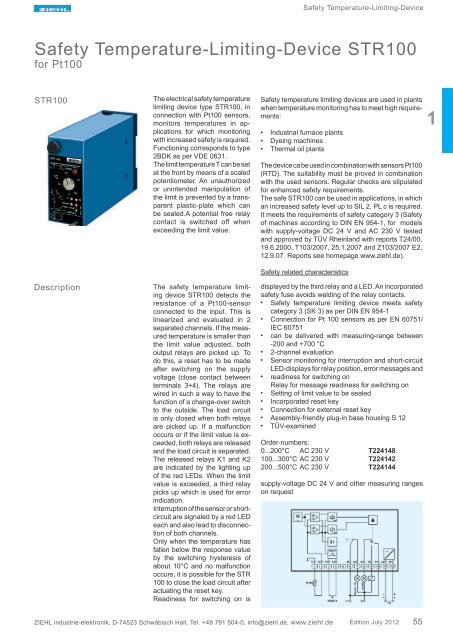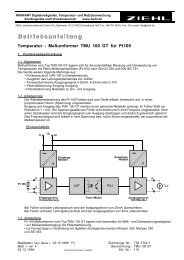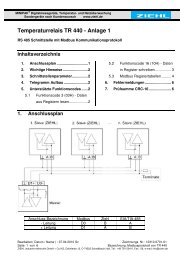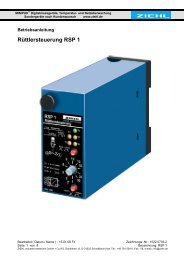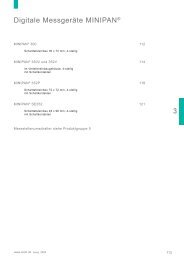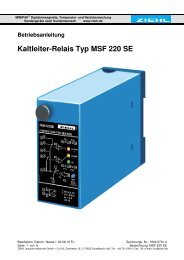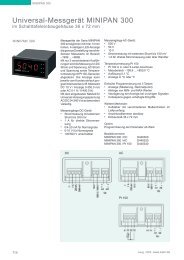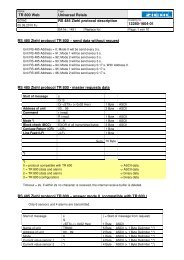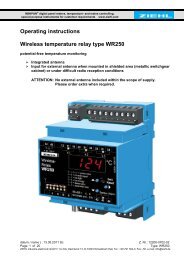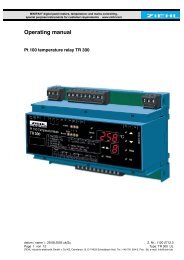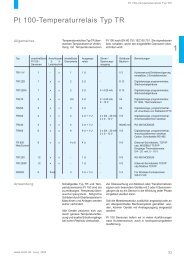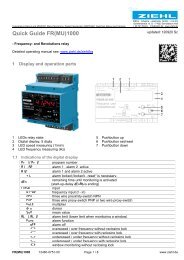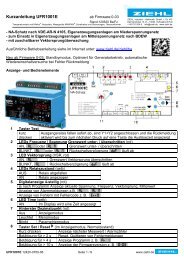Safety Temperature-Limiting-Device STR100 - ziehl.de
Safety Temperature-Limiting-Device STR100 - ziehl.de
Safety Temperature-Limiting-Device STR100 - ziehl.de
You also want an ePaper? Increase the reach of your titles
YUMPU automatically turns print PDFs into web optimized ePapers that Google loves.
<strong>STR100</strong><br />
Description<br />
The safety temperature limiting<br />
<strong>de</strong>vice <strong>STR100</strong> <strong>de</strong>tects the<br />
resistance of a Pt100-sensor<br />
connected to the input. This is<br />
linearized and evaluated in 2<br />
separated channels. If the measured<br />
temperature is smaller than<br />
the limit value adjusted, both<br />
output relays are picked up. To<br />
do this, a reset has to be ma<strong>de</strong><br />
after switching on the supply<br />
voltage (close contact between<br />
terminals 3+4). The relays are<br />
wired in such a way to have the<br />
function of a change-over switch<br />
to the outsi<strong>de</strong>. The load circuit<br />
is only closed when both relays<br />
are picked up. If a malfunction<br />
occurs or if the limit value is excee<strong>de</strong>d,<br />
both relays are released<br />
and the load circuit is separated.<br />
The released relays K1 and K2<br />
are indicated by the lighting up<br />
of the red LEDs. When the limit<br />
value is excee<strong>de</strong>d, a third relay<br />
picks up which is used for error<br />
indication.<br />
Interruption of the sensor or shortcircuit<br />
are signaled by a red LED<br />
each and also lead to disconnection<br />
of both channels.<br />
Only when the temperature has<br />
fallen below the response value<br />
by the switching hysteresis of<br />
about 10°C and no malfunction<br />
occurs, it is possible for the STR<br />
100 to close the load circuit after<br />
actuating the reset key.<br />
Readiness for switching on is<br />
ZIEHL industrie-elektronik, D-74523 Schwäbisch Hall, Tel. +49 791 504-0, info@<strong>ziehl</strong>.<strong>de</strong>, www.<strong>ziehl</strong>.<strong>de</strong><br />
<strong>Safety</strong> <strong>Temperature</strong>-<strong>Limiting</strong>-<strong>Device</strong><br />
<strong>Safety</strong> <strong>Temperature</strong>-<strong>Limiting</strong>-<strong>Device</strong> <strong>STR100</strong><br />
for Pt100<br />
The electrical safety temperature<br />
limiting <strong>de</strong>vice type <strong>STR100</strong>, in<br />
connection with Pt100 sensors,<br />
monitors temperatures in applications<br />
for which monitoring<br />
with increased safety is required.<br />
Functioning corresponds to type<br />
2BDK as per VDE 0631.<br />
The limit temperature T can be set<br />
at the front by means of a scaled<br />
potentiometer. An unauthorized<br />
or uninten<strong>de</strong>d manipulation of<br />
the limit is prevented by a transparent<br />
plastic-plate which can<br />
be sealed.A potential free relay<br />
contact is switched off when<br />
exceeding the limit value.<br />
<strong>Safety</strong> temperature limiting <strong>de</strong>vices are used in plants<br />
when temperature monitoring has to meet high requirements:<br />
• Industrial furnace plants<br />
• Dyeing machines<br />
• Thermal oil plants<br />
The <strong>de</strong>vice ca be used in combination with sensors Pt100<br />
(RTD). The suitability must be proved in combination<br />
with the used sensors. Regular checks are stipulated<br />
for enhanced safety requirements.<br />
The safe <strong>STR100</strong> can be used in applications, in which<br />
an increased safety level up to SIL 2, PL c is required.<br />
It meets the requirements of safety category 3 (<strong>Safety</strong><br />
of machines according to DIN EN 954-1, for mo<strong>de</strong>ls<br />
with supply-voltage DC 24 V and AC 230 V tested<br />
and approved by TÜV Rheinland with reports T24/00,<br />
19.6.2000, T103/2007, 25.1.2007 and Z103/2007 E2,<br />
12.9.07. Reports see homepage www.<strong>ziehl</strong>.<strong>de</strong>).<br />
<strong>Safety</strong> related characteristics<br />
displayed by the third relay and a LED. An incorporated<br />
safety fuse avoids welding of the relay contacts.<br />
• <strong>Safety</strong> temperature limiting <strong>de</strong>vice meets safety<br />
category 3 (SK 3) as per DIN EN 954-1<br />
• Connection for Pt 100 sensors as per EN 60751/<br />
IEC 60751<br />
• can be <strong>de</strong>livered with measuring-range between<br />
-200 and +700 °C<br />
• 2-channel evaluation<br />
• Sensor monitoring for interruption and short-circuit<br />
LED-displays for relay position, error messages and<br />
• readiness for switching on<br />
Relay for message readiness for switching on<br />
• Setting of limit value to be sealed<br />
• Incorporated reset key<br />
• Connection for external reset key<br />
• Assembly-friendly plug-in base housing S 12<br />
• TÜV-examined<br />
Or<strong>de</strong>r-numbers:<br />
0...200°C AC 230 V T224148<br />
100...300°C AC 230 V T224142<br />
200...500°C AC 230 V T224144<br />
supply-voltage DC 24 V and other measuring ranges<br />
on request<br />
Edition July 2012<br />
55<br />
1
<strong>Safety</strong> <strong>Temperature</strong>-<strong>Limiting</strong>-<strong>Device</strong><br />
Technische Daten <strong>STR100</strong><br />
Power supply<br />
Sensor-Input<br />
Switching points<br />
Relay outputs<br />
Testing conditions<br />
Housing<br />
Rated supply-voltage Us<br />
Adm. tolerance Us<br />
Power consumption<br />
Frequency<br />
Max. current<br />
Max. voltage<br />
Line resistance<br />
Switching off<br />
Limit value T<br />
Switching hysteresis<br />
Reset<br />
Switching voltage<br />
Switching current<br />
Switching power<br />
nominal continous current Ith<br />
nominal operating current Ie<br />
recommen<strong>de</strong>d fuse for contacts<br />
expected life mechanical<br />
expected life electrical<br />
<strong>de</strong>rating factor cos ϕ 0,3<br />
Rated insulation voltage<br />
Contamination level<br />
Rated impulse withstand voltage<br />
Overvolatage category<br />
Transformer<br />
Interference resistance industry<br />
Interference transmission<br />
"on"-period<br />
Rated ambient temperature<br />
range<br />
Dimensions H x B x T<br />
wire-connection<br />
Protection housing<br />
Protection terminals<br />
Fitting position<br />
Fastening<br />
Vibration resistance<br />
Shock resistance<br />
Weight<br />
AC 230 V DC 24 V<br />
-10...+10% -15...+25%<br />
< 2 VA < 3W<br />
50/60 Hz<br />
2-wire Pt 100 acc. to EN 60751/IEC 751, α = 0,00385<br />
< 3,15 mA (< 10 mA bei -200...+0°C)<br />
< 2 V, open terminals < 15 V<br />
Standard = 0,5 Ω, Option: max. 30 Ω<br />
Over-temperature, sensor break, sensor short circuit<br />
and malfunction<br />
adjustable<br />
10°C (±25%)<br />
with reset key at the front or an external key<br />
1 change-over contact (CO)<br />
max. AC 400 V max. DC 300 V<br />
max. 6 A<br />
max. 2000 VA (ohmic load)<br />
max. 48 W at DC 24 V<br />
6 A<br />
2 A AC 15 400V 2 A DC 13 24 V<br />
4 A AC 11/AC 15 230V<br />
3,15 A slow blow, 4 A flink<br />
3 x 10 7 operations<br />
1 x 10 5 operations with 240 V/6 A<br />
0,5<br />
EN 50178, EN 61010-1, EN 60947-5<br />
AC 250 V<br />
2 (normal)<br />
4000 V<br />
III<br />
EN 61558-2-6 (VDE 0551)<br />
EN 61000-6-2, EN 61326-1<br />
Class B EN 50081-1<br />
100 %<br />
0...50°C EN 60068-2-1 dry heat<br />
Design S 12 (plugable): 82 x 42 x 121 [mm]<br />
12-pole, each 2 x 1,5 mm 2<br />
IP 40<br />
IP 20<br />
any<br />
Snap mounting on 35 mm standard rail conforms to<br />
DIN EN 50 022 or M4 screws<br />
1 mm <strong>de</strong>flection 25 Hz/ 10 g 25-100 Hz<br />
10 g 20 ms<br />
20 g 4 ms<br />
approx. 300 g<br />
56 ZIEHL industrie-elektronik, D-74523 Schwäbisch Hall, Tel. +49 791 504-0, info@<strong>ziehl</strong>.<strong>de</strong>, www.<strong>ziehl</strong>.<strong>de</strong><br />
Edition July 2012


